Leadership Effectiveness: A Critical Analysis of a Journal Article
VerifiedAdded on 2020/12/18
|12
|3040
|68
Report
AI Summary
This report provides a critical analysis of a journal article focusing on leadership effectiveness. The article explores the integration of trait and behavioral theories of leadership, examining their relative validity based on four leadership effectiveness criteria: group performance, job satisfaction of followers, satisfaction with the leader, and leader effectiveness. The analysis delves into the criteria for leadership effectiveness, highlighting different perspectives and models, including contingency models and the importance of spiritual practices and values. It also examines the leader trait paradigm, discussing various traits that differentiate leaders and the significance of interpersonal attributes. The report also discusses the difference between transactional and transformational leaders. The report further explores the different criteria for measuring leadership effectiveness, along with the skills required to be an effective leader. The analysis concludes with an evaluation of the leader trait paradigm and its limitations.
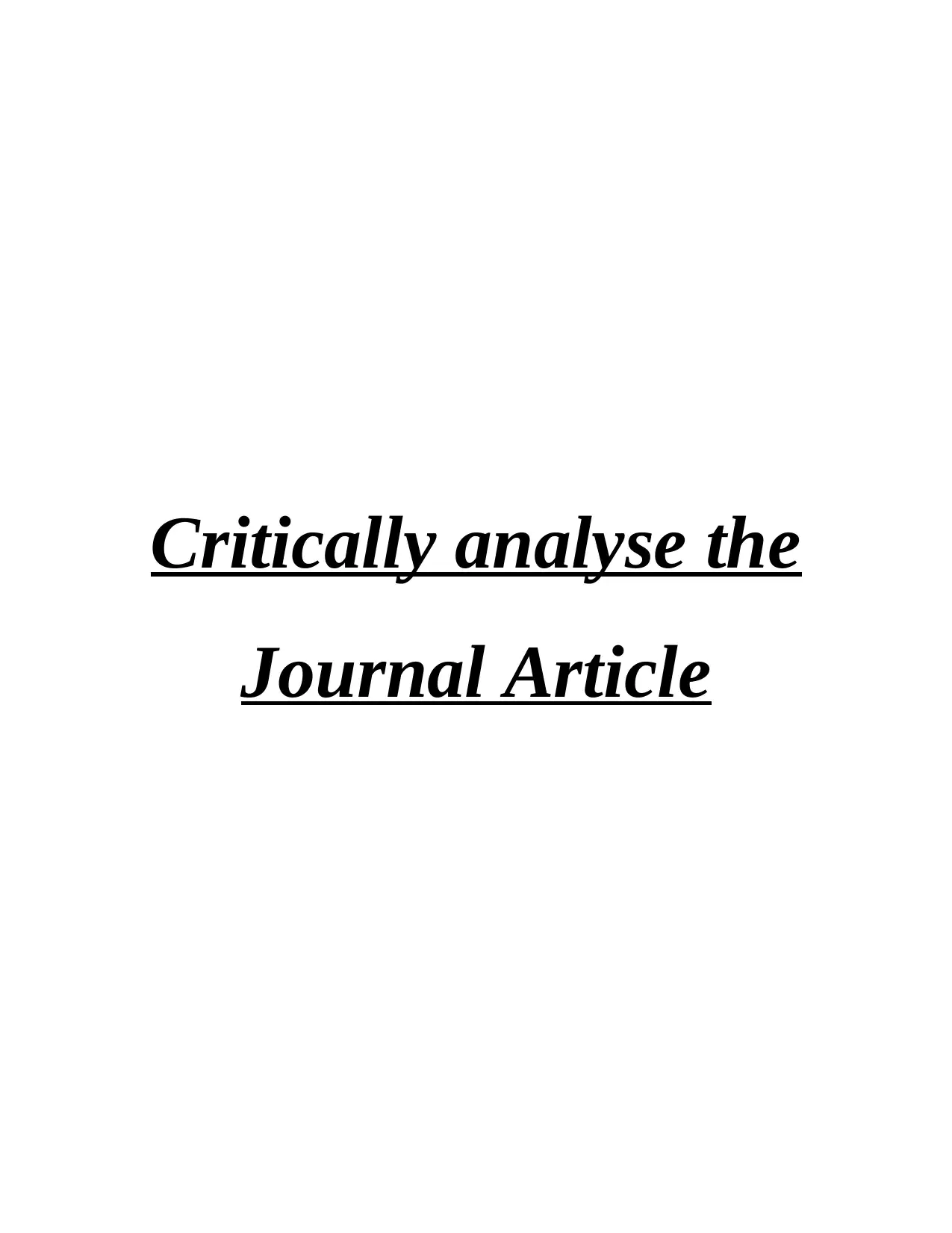
Critically analyse the
Journal Article
Journal Article
Paraphrase This Document
Need a fresh take? Get an instant paraphrase of this document with our AI Paraphraser
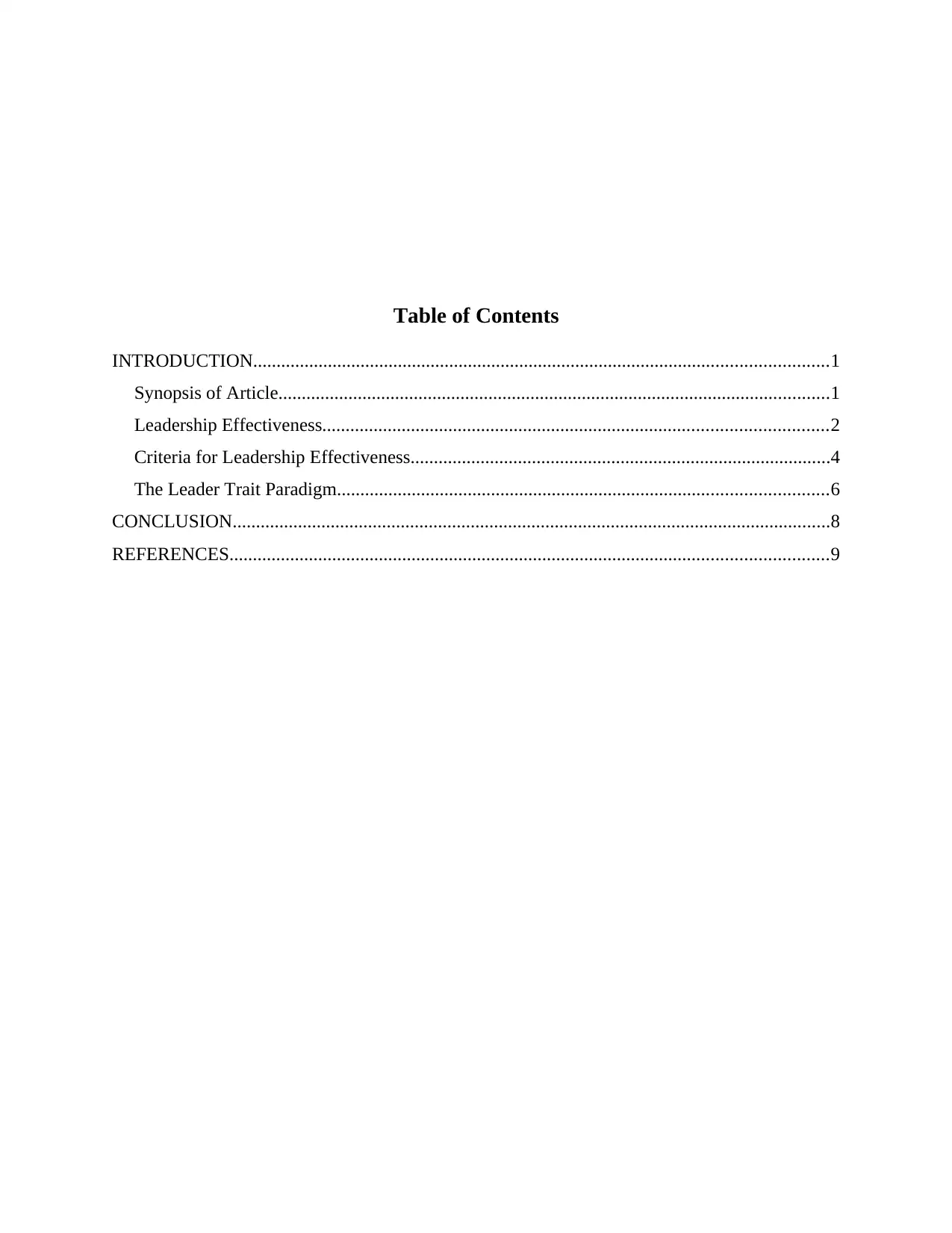
Table of Contents
INTRODUCTION...........................................................................................................................1
Synopsis of Article......................................................................................................................1
Leadership Effectiveness............................................................................................................2
Criteria for Leadership Effectiveness..........................................................................................4
The Leader Trait Paradigm.........................................................................................................6
CONCLUSION................................................................................................................................8
REFERENCES................................................................................................................................9
INTRODUCTION...........................................................................................................................1
Synopsis of Article......................................................................................................................1
Leadership Effectiveness............................................................................................................2
Criteria for Leadership Effectiveness..........................................................................................4
The Leader Trait Paradigm.........................................................................................................6
CONCLUSION................................................................................................................................8
REFERENCES................................................................................................................................9

⊘ This is a preview!⊘
Do you want full access?
Subscribe today to unlock all pages.

Trusted by 1+ million students worldwide
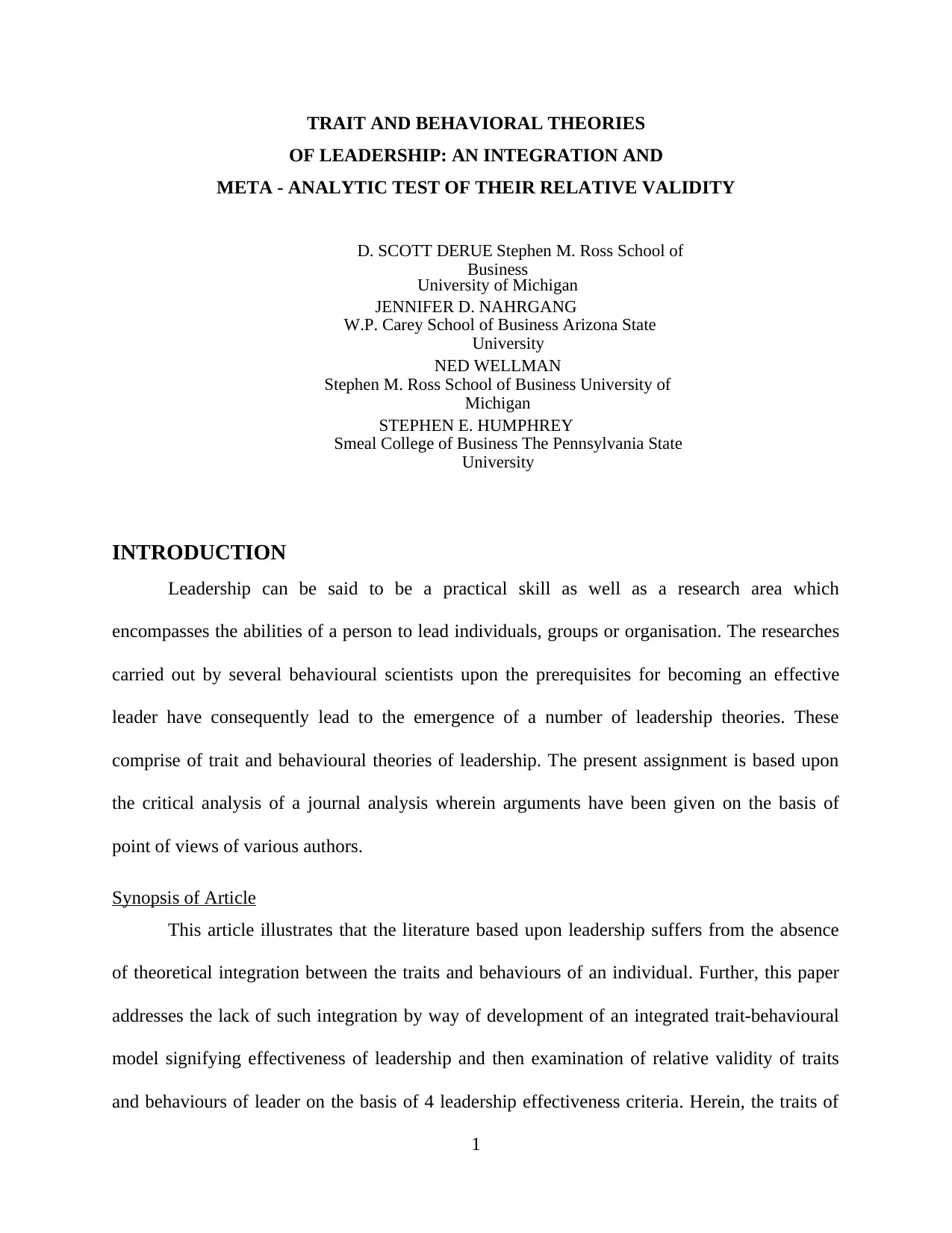
TRAIT AND BEHAVIORAL THEORIES
OF LEADERSHIP: AN INTEGRATION AND
META - ANALYTIC TEST OF THEIR RELATIVE VALIDITY
D. SCOTT DERUE Stephen M. Ross School of
Business
University of Michigan
JENNIFER D. NAHRGANG
W.P. Carey School of Business Arizona State
University
NED WELLMAN
Stephen M. Ross School of Business University of
Michigan
STEPHEN E. HUMPHREY
Smeal College of Business The Pennsylvania State
University
INTRODUCTION
Leadership can be said to be a practical skill as well as a research area which
encompasses the abilities of a person to lead individuals, groups or organisation. The researches
carried out by several behavioural scientists upon the prerequisites for becoming an effective
leader have consequently lead to the emergence of a number of leadership theories. These
comprise of trait and behavioural theories of leadership. The present assignment is based upon
the critical analysis of a journal analysis wherein arguments have been given on the basis of
point of views of various authors.
Synopsis of Article
This article illustrates that the literature based upon leadership suffers from the absence
of theoretical integration between the traits and behaviours of an individual. Further, this paper
addresses the lack of such integration by way of development of an integrated trait-behavioural
model signifying effectiveness of leadership and then examination of relative validity of traits
and behaviours of leader on the basis of 4 leadership effectiveness criteria. Herein, the traits of
1
OF LEADERSHIP: AN INTEGRATION AND
META - ANALYTIC TEST OF THEIR RELATIVE VALIDITY
D. SCOTT DERUE Stephen M. Ross School of
Business
University of Michigan
JENNIFER D. NAHRGANG
W.P. Carey School of Business Arizona State
University
NED WELLMAN
Stephen M. Ross School of Business University of
Michigan
STEPHEN E. HUMPHREY
Smeal College of Business The Pennsylvania State
University
INTRODUCTION
Leadership can be said to be a practical skill as well as a research area which
encompasses the abilities of a person to lead individuals, groups or organisation. The researches
carried out by several behavioural scientists upon the prerequisites for becoming an effective
leader have consequently lead to the emergence of a number of leadership theories. These
comprise of trait and behavioural theories of leadership. The present assignment is based upon
the critical analysis of a journal analysis wherein arguments have been given on the basis of
point of views of various authors.
Synopsis of Article
This article illustrates that the literature based upon leadership suffers from the absence
of theoretical integration between the traits and behaviours of an individual. Further, this paper
addresses the lack of such integration by way of development of an integrated trait-behavioural
model signifying effectiveness of leadership and then examination of relative validity of traits
and behaviours of leader on the basis of 4 leadership effectiveness criteria. Herein, the traits of
1
Paraphrase This Document
Need a fresh take? Get an instant paraphrase of this document with our AI Paraphraser
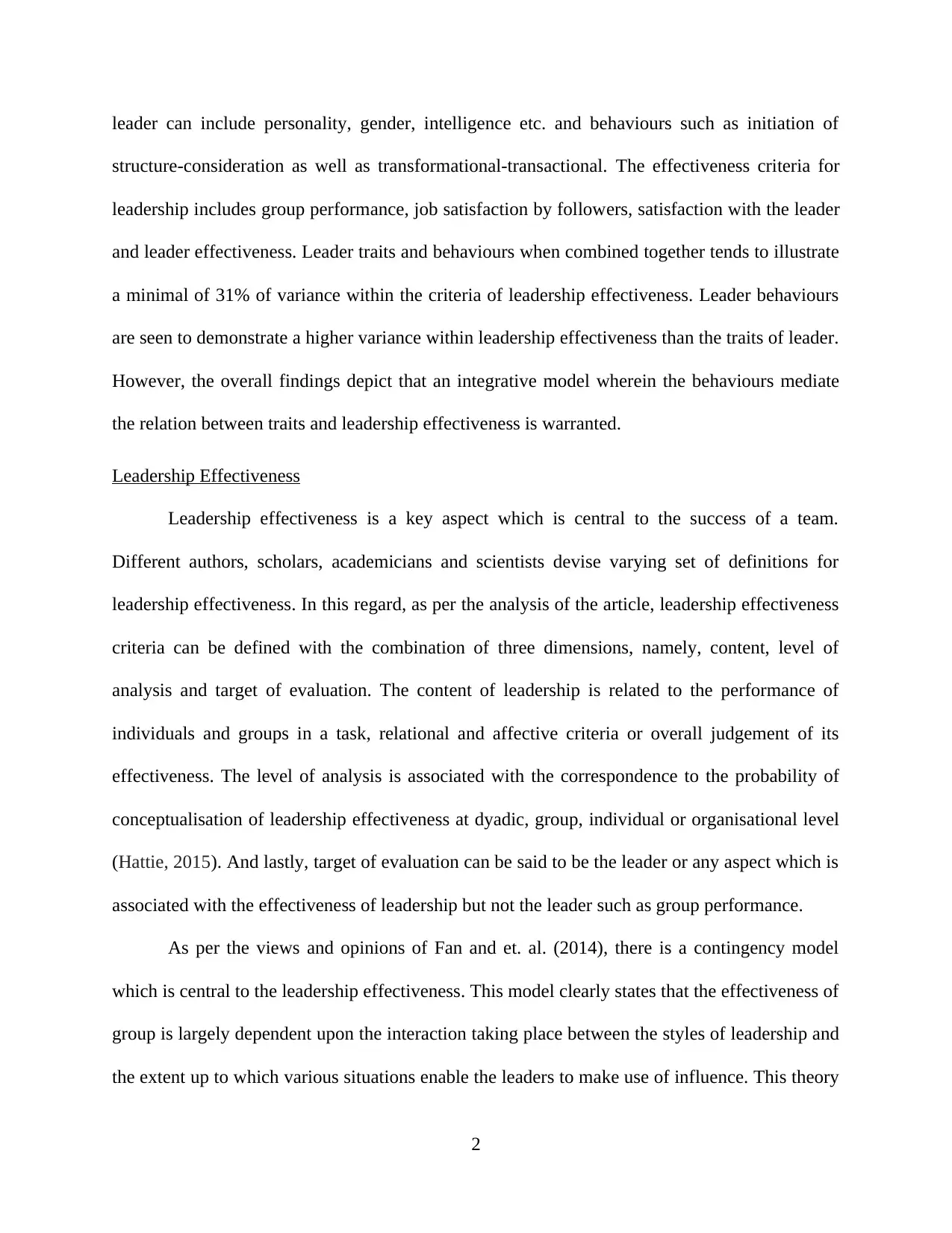
leader can include personality, gender, intelligence etc. and behaviours such as initiation of
structure-consideration as well as transformational-transactional. The effectiveness criteria for
leadership includes group performance, job satisfaction by followers, satisfaction with the leader
and leader effectiveness. Leader traits and behaviours when combined together tends to illustrate
a minimal of 31% of variance within the criteria of leadership effectiveness. Leader behaviours
are seen to demonstrate a higher variance within leadership effectiveness than the traits of leader.
However, the overall findings depict that an integrative model wherein the behaviours mediate
the relation between traits and leadership effectiveness is warranted.
Leadership Effectiveness
Leadership effectiveness is a key aspect which is central to the success of a team.
Different authors, scholars, academicians and scientists devise varying set of definitions for
leadership effectiveness. In this regard, as per the analysis of the article, leadership effectiveness
criteria can be defined with the combination of three dimensions, namely, content, level of
analysis and target of evaluation. The content of leadership is related to the performance of
individuals and groups in a task, relational and affective criteria or overall judgement of its
effectiveness. The level of analysis is associated with the correspondence to the probability of
conceptualisation of leadership effectiveness at dyadic, group, individual or organisational level
(Hattie, 2015). And lastly, target of evaluation can be said to be the leader or any aspect which is
associated with the effectiveness of leadership but not the leader such as group performance.
As per the views and opinions of Fan and et. al. (2014), there is a contingency model
which is central to the leadership effectiveness. This model clearly states that the effectiveness of
group is largely dependent upon the interaction taking place between the styles of leadership and
the extent up to which various situations enable the leaders to make use of influence. This theory
2
structure-consideration as well as transformational-transactional. The effectiveness criteria for
leadership includes group performance, job satisfaction by followers, satisfaction with the leader
and leader effectiveness. Leader traits and behaviours when combined together tends to illustrate
a minimal of 31% of variance within the criteria of leadership effectiveness. Leader behaviours
are seen to demonstrate a higher variance within leadership effectiveness than the traits of leader.
However, the overall findings depict that an integrative model wherein the behaviours mediate
the relation between traits and leadership effectiveness is warranted.
Leadership Effectiveness
Leadership effectiveness is a key aspect which is central to the success of a team.
Different authors, scholars, academicians and scientists devise varying set of definitions for
leadership effectiveness. In this regard, as per the analysis of the article, leadership effectiveness
criteria can be defined with the combination of three dimensions, namely, content, level of
analysis and target of evaluation. The content of leadership is related to the performance of
individuals and groups in a task, relational and affective criteria or overall judgement of its
effectiveness. The level of analysis is associated with the correspondence to the probability of
conceptualisation of leadership effectiveness at dyadic, group, individual or organisational level
(Hattie, 2015). And lastly, target of evaluation can be said to be the leader or any aspect which is
associated with the effectiveness of leadership but not the leader such as group performance.
As per the views and opinions of Fan and et. al. (2014), there is a contingency model
which is central to the leadership effectiveness. This model clearly states that the effectiveness of
group is largely dependent upon the interaction taking place between the styles of leadership and
the extent up to which various situations enable the leaders to make use of influence. This theory
2
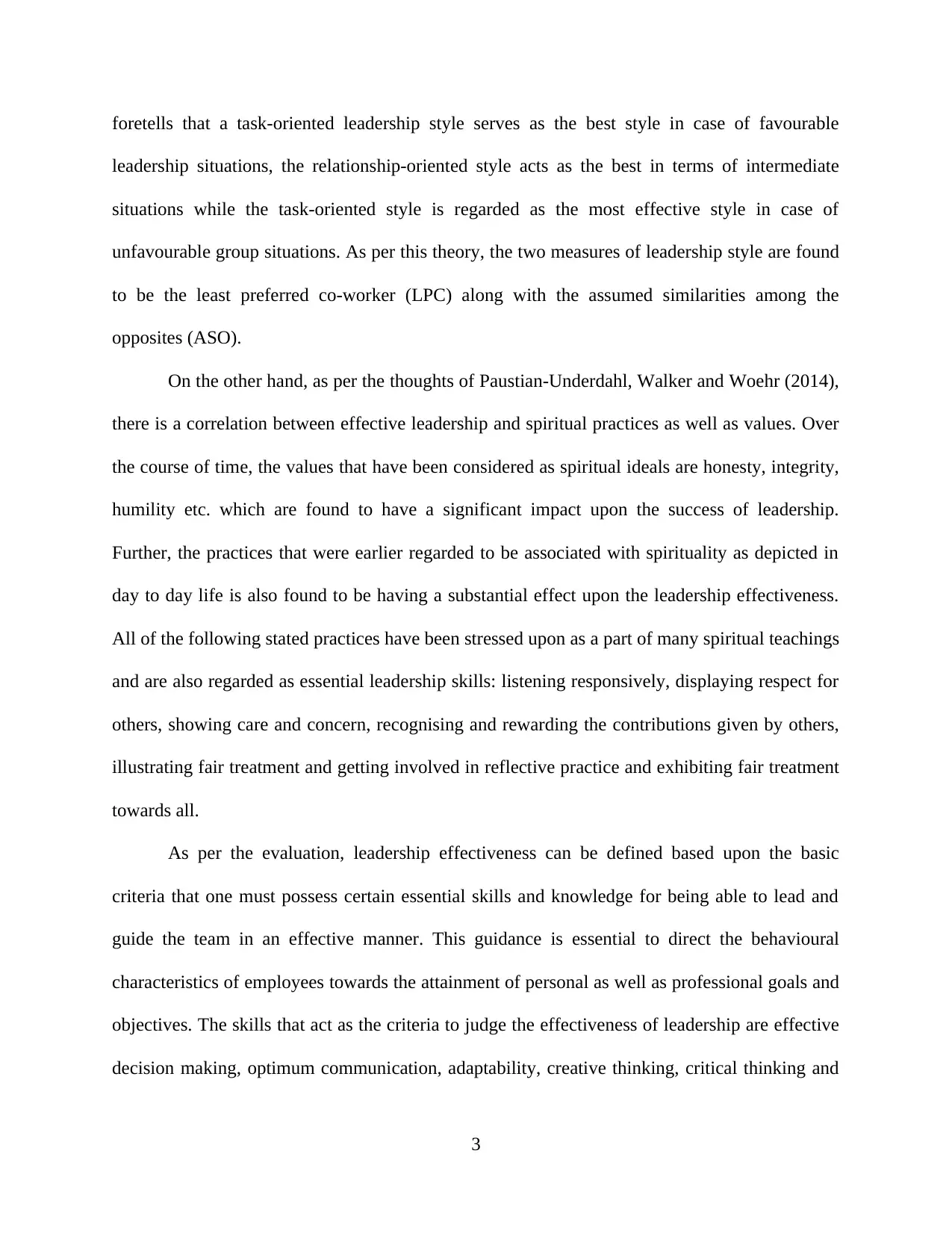
foretells that a task-oriented leadership style serves as the best style in case of favourable
leadership situations, the relationship-oriented style acts as the best in terms of intermediate
situations while the task-oriented style is regarded as the most effective style in case of
unfavourable group situations. As per this theory, the two measures of leadership style are found
to be the least preferred co-worker (LPC) along with the assumed similarities among the
opposites (ASO).
On the other hand, as per the thoughts of Paustian-Underdahl, Walker and Woehr (2014),
there is a correlation between effective leadership and spiritual practices as well as values. Over
the course of time, the values that have been considered as spiritual ideals are honesty, integrity,
humility etc. which are found to have a significant impact upon the success of leadership.
Further, the practices that were earlier regarded to be associated with spirituality as depicted in
day to day life is also found to be having a substantial effect upon the leadership effectiveness.
All of the following stated practices have been stressed upon as a part of many spiritual teachings
and are also regarded as essential leadership skills: listening responsively, displaying respect for
others, showing care and concern, recognising and rewarding the contributions given by others,
illustrating fair treatment and getting involved in reflective practice and exhibiting fair treatment
towards all.
As per the evaluation, leadership effectiveness can be defined based upon the basic
criteria that one must possess certain essential skills and knowledge for being able to lead and
guide the team in an effective manner. This guidance is essential to direct the behavioural
characteristics of employees towards the attainment of personal as well as professional goals and
objectives. The skills that act as the criteria to judge the effectiveness of leadership are effective
decision making, optimum communication, adaptability, creative thinking, critical thinking and
3
leadership situations, the relationship-oriented style acts as the best in terms of intermediate
situations while the task-oriented style is regarded as the most effective style in case of
unfavourable group situations. As per this theory, the two measures of leadership style are found
to be the least preferred co-worker (LPC) along with the assumed similarities among the
opposites (ASO).
On the other hand, as per the thoughts of Paustian-Underdahl, Walker and Woehr (2014),
there is a correlation between effective leadership and spiritual practices as well as values. Over
the course of time, the values that have been considered as spiritual ideals are honesty, integrity,
humility etc. which are found to have a significant impact upon the success of leadership.
Further, the practices that were earlier regarded to be associated with spirituality as depicted in
day to day life is also found to be having a substantial effect upon the leadership effectiveness.
All of the following stated practices have been stressed upon as a part of many spiritual teachings
and are also regarded as essential leadership skills: listening responsively, displaying respect for
others, showing care and concern, recognising and rewarding the contributions given by others,
illustrating fair treatment and getting involved in reflective practice and exhibiting fair treatment
towards all.
As per the evaluation, leadership effectiveness can be defined based upon the basic
criteria that one must possess certain essential skills and knowledge for being able to lead and
guide the team in an effective manner. This guidance is essential to direct the behavioural
characteristics of employees towards the attainment of personal as well as professional goals and
objectives. The skills that act as the criteria to judge the effectiveness of leadership are effective
decision making, optimum communication, adaptability, creative thinking, critical thinking and
3
⊘ This is a preview!⊘
Do you want full access?
Subscribe today to unlock all pages.

Trusted by 1+ million students worldwide
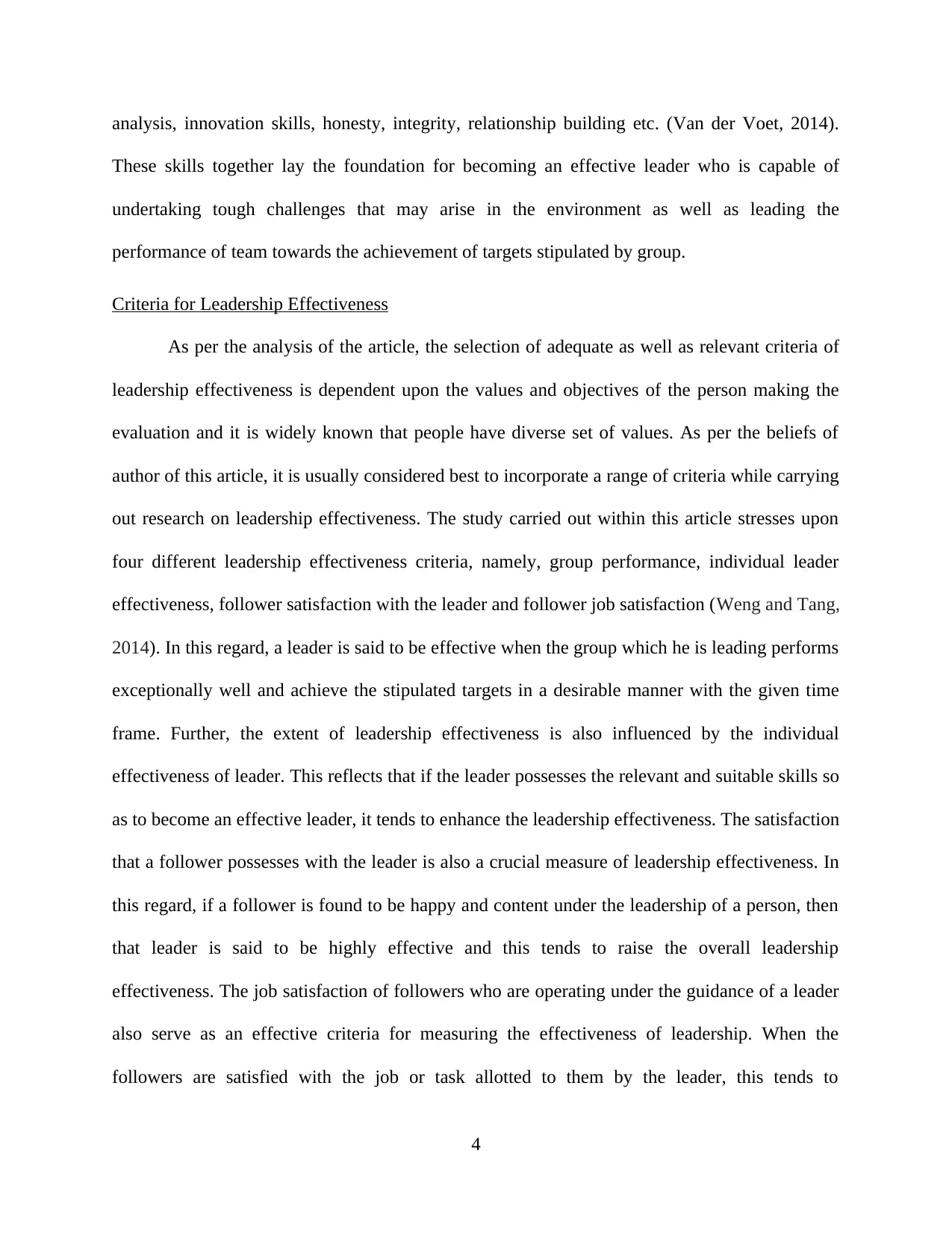
analysis, innovation skills, honesty, integrity, relationship building etc. (Van der Voet, 2014).
These skills together lay the foundation for becoming an effective leader who is capable of
undertaking tough challenges that may arise in the environment as well as leading the
performance of team towards the achievement of targets stipulated by group.
Criteria for Leadership Effectiveness
As per the analysis of the article, the selection of adequate as well as relevant criteria of
leadership effectiveness is dependent upon the values and objectives of the person making the
evaluation and it is widely known that people have diverse set of values. As per the beliefs of
author of this article, it is usually considered best to incorporate a range of criteria while carrying
out research on leadership effectiveness. The study carried out within this article stresses upon
four different leadership effectiveness criteria, namely, group performance, individual leader
effectiveness, follower satisfaction with the leader and follower job satisfaction (Weng and Tang,
2014). In this regard, a leader is said to be effective when the group which he is leading performs
exceptionally well and achieve the stipulated targets in a desirable manner with the given time
frame. Further, the extent of leadership effectiveness is also influenced by the individual
effectiveness of leader. This reflects that if the leader possesses the relevant and suitable skills so
as to become an effective leader, it tends to enhance the leadership effectiveness. The satisfaction
that a follower possesses with the leader is also a crucial measure of leadership effectiveness. In
this regard, if a follower is found to be happy and content under the leadership of a person, then
that leader is said to be highly effective and this tends to raise the overall leadership
effectiveness. The job satisfaction of followers who are operating under the guidance of a leader
also serve as an effective criteria for measuring the effectiveness of leadership. When the
followers are satisfied with the job or task allotted to them by the leader, this tends to
4
These skills together lay the foundation for becoming an effective leader who is capable of
undertaking tough challenges that may arise in the environment as well as leading the
performance of team towards the achievement of targets stipulated by group.
Criteria for Leadership Effectiveness
As per the analysis of the article, the selection of adequate as well as relevant criteria of
leadership effectiveness is dependent upon the values and objectives of the person making the
evaluation and it is widely known that people have diverse set of values. As per the beliefs of
author of this article, it is usually considered best to incorporate a range of criteria while carrying
out research on leadership effectiveness. The study carried out within this article stresses upon
four different leadership effectiveness criteria, namely, group performance, individual leader
effectiveness, follower satisfaction with the leader and follower job satisfaction (Weng and Tang,
2014). In this regard, a leader is said to be effective when the group which he is leading performs
exceptionally well and achieve the stipulated targets in a desirable manner with the given time
frame. Further, the extent of leadership effectiveness is also influenced by the individual
effectiveness of leader. This reflects that if the leader possesses the relevant and suitable skills so
as to become an effective leader, it tends to enhance the leadership effectiveness. The satisfaction
that a follower possesses with the leader is also a crucial measure of leadership effectiveness. In
this regard, if a follower is found to be happy and content under the leadership of a person, then
that leader is said to be highly effective and this tends to raise the overall leadership
effectiveness. The job satisfaction of followers who are operating under the guidance of a leader
also serve as an effective criteria for measuring the effectiveness of leadership. When the
followers are satisfied with the job or task allotted to them by the leader, this tends to
4
Paraphrase This Document
Need a fresh take? Get an instant paraphrase of this document with our AI Paraphraser

significantly enhance the leadership effectiveness. Thus, the before mentioned criteria are
analysed and measured so as to determine the extent of leadership effectiveness. There are two
folded reasons behind selection of this criteria. The first one is the intention to include a wide
range of content dimensions, levels of analysis and the targets of evaluation. The individual
effectiveness of leader render a leader focused and individual level assessment of the overall
effectiveness. Group performance provides a group- level, personnel-focused examination of
task-related performance along with the follower satisfaction with the job as well as leader
(Trivellas and Reklitis, 2014). This renders an effective, individual-level and others-focused
assessment of the leadership effectiveness. Secondly, provided that meta-analytical techniques
are used, just those criteria which have been assessed on the basis of a number of studies can be
incorporated. With such criteria, both these parameters can be met and the relative validity of
behaviours as well as traits can be examined over a diverse set of criteria for leadership
effectiveness.
As per the views and opinions of Wang, Waldman and Zhang (2014), the definite way to
measure the effectiveness of leader is difficult to ascertain owing to the fact that the leadership
style adopted by an individual varies from person to person and is influenced by the method used
by a person to tackle with a situation. In this regard, usually leadership is measured by the ability
of a person to encourage as well as influence change across an organisational premises or a
community. Accordingly, leadership effectiveness is principally dependent upon the ability of a
leader to gain relevant and sufficient outcomes in relation to ascertaining if the leader tends to
have a favourable or adverse influence upon the followers. In ascertaining the effectiveness of a
leader, it is essential to assess whether one is a transactional or transformational leader. In this
regard, transformational leaders are found to have the capabilities to motivate employees in a
5
analysed and measured so as to determine the extent of leadership effectiveness. There are two
folded reasons behind selection of this criteria. The first one is the intention to include a wide
range of content dimensions, levels of analysis and the targets of evaluation. The individual
effectiveness of leader render a leader focused and individual level assessment of the overall
effectiveness. Group performance provides a group- level, personnel-focused examination of
task-related performance along with the follower satisfaction with the job as well as leader
(Trivellas and Reklitis, 2014). This renders an effective, individual-level and others-focused
assessment of the leadership effectiveness. Secondly, provided that meta-analytical techniques
are used, just those criteria which have been assessed on the basis of a number of studies can be
incorporated. With such criteria, both these parameters can be met and the relative validity of
behaviours as well as traits can be examined over a diverse set of criteria for leadership
effectiveness.
As per the views and opinions of Wang, Waldman and Zhang (2014), the definite way to
measure the effectiveness of leader is difficult to ascertain owing to the fact that the leadership
style adopted by an individual varies from person to person and is influenced by the method used
by a person to tackle with a situation. In this regard, usually leadership is measured by the ability
of a person to encourage as well as influence change across an organisational premises or a
community. Accordingly, leadership effectiveness is principally dependent upon the ability of a
leader to gain relevant and sufficient outcomes in relation to ascertaining if the leader tends to
have a favourable or adverse influence upon the followers. In ascertaining the effectiveness of a
leader, it is essential to assess whether one is a transactional or transformational leader. In this
regard, transformational leaders are found to have the capabilities to motivate employees in a
5
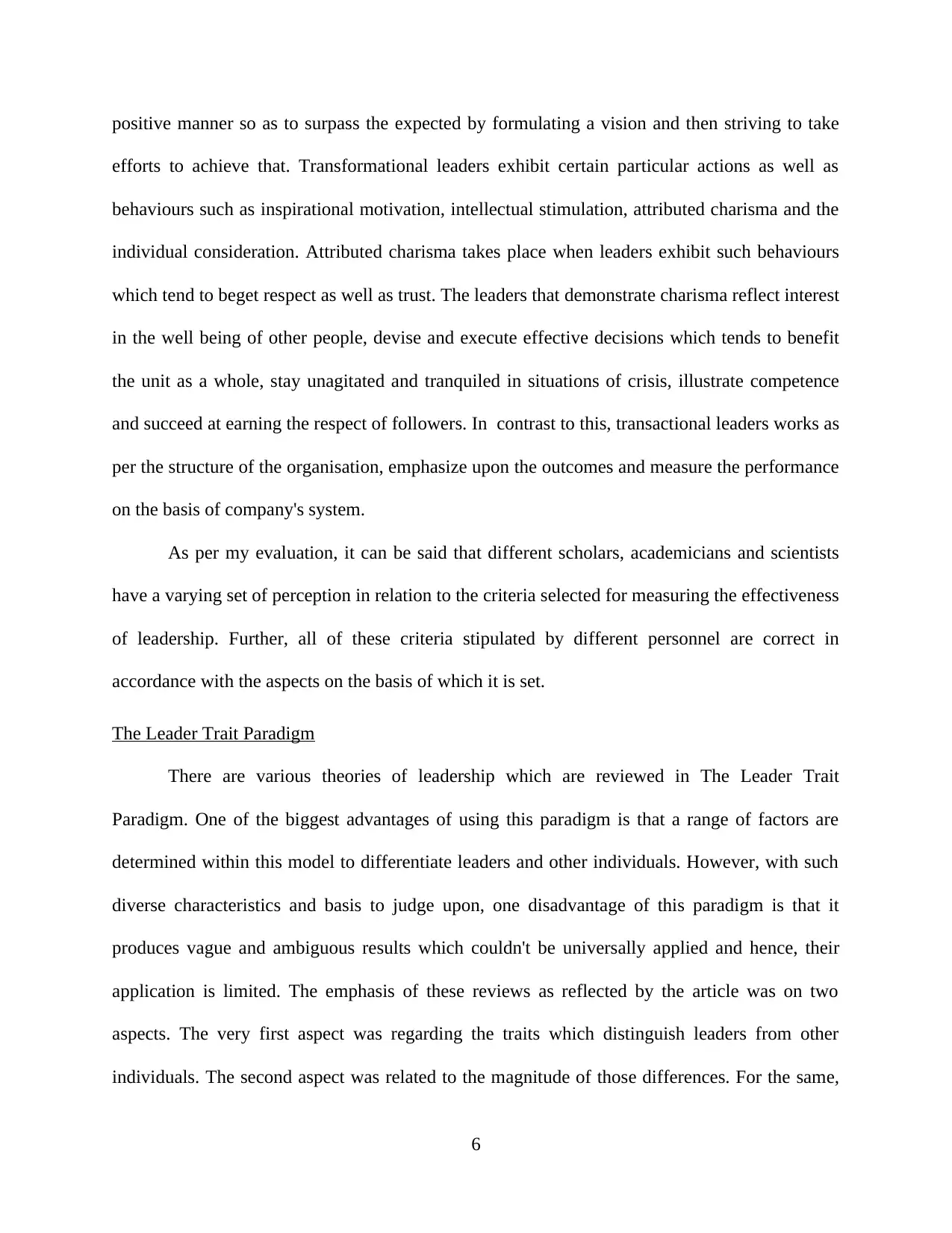
positive manner so as to surpass the expected by formulating a vision and then striving to take
efforts to achieve that. Transformational leaders exhibit certain particular actions as well as
behaviours such as inspirational motivation, intellectual stimulation, attributed charisma and the
individual consideration. Attributed charisma takes place when leaders exhibit such behaviours
which tend to beget respect as well as trust. The leaders that demonstrate charisma reflect interest
in the well being of other people, devise and execute effective decisions which tends to benefit
the unit as a whole, stay unagitated and tranquiled in situations of crisis, illustrate competence
and succeed at earning the respect of followers. In contrast to this, transactional leaders works as
per the structure of the organisation, emphasize upon the outcomes and measure the performance
on the basis of company's system.
As per my evaluation, it can be said that different scholars, academicians and scientists
have a varying set of perception in relation to the criteria selected for measuring the effectiveness
of leadership. Further, all of these criteria stipulated by different personnel are correct in
accordance with the aspects on the basis of which it is set.
The Leader Trait Paradigm
There are various theories of leadership which are reviewed in The Leader Trait
Paradigm. One of the biggest advantages of using this paradigm is that a range of factors are
determined within this model to differentiate leaders and other individuals. However, with such
diverse characteristics and basis to judge upon, one disadvantage of this paradigm is that it
produces vague and ambiguous results which couldn't be universally applied and hence, their
application is limited. The emphasis of these reviews as reflected by the article was on two
aspects. The very first aspect was regarding the traits which distinguish leaders from other
individuals. The second aspect was related to the magnitude of those differences. For the same,
6
efforts to achieve that. Transformational leaders exhibit certain particular actions as well as
behaviours such as inspirational motivation, intellectual stimulation, attributed charisma and the
individual consideration. Attributed charisma takes place when leaders exhibit such behaviours
which tend to beget respect as well as trust. The leaders that demonstrate charisma reflect interest
in the well being of other people, devise and execute effective decisions which tends to benefit
the unit as a whole, stay unagitated and tranquiled in situations of crisis, illustrate competence
and succeed at earning the respect of followers. In contrast to this, transactional leaders works as
per the structure of the organisation, emphasize upon the outcomes and measure the performance
on the basis of company's system.
As per my evaluation, it can be said that different scholars, academicians and scientists
have a varying set of perception in relation to the criteria selected for measuring the effectiveness
of leadership. Further, all of these criteria stipulated by different personnel are correct in
accordance with the aspects on the basis of which it is set.
The Leader Trait Paradigm
There are various theories of leadership which are reviewed in The Leader Trait
Paradigm. One of the biggest advantages of using this paradigm is that a range of factors are
determined within this model to differentiate leaders and other individuals. However, with such
diverse characteristics and basis to judge upon, one disadvantage of this paradigm is that it
produces vague and ambiguous results which couldn't be universally applied and hence, their
application is limited. The emphasis of these reviews as reflected by the article was on two
aspects. The very first aspect was regarding the traits which distinguish leaders from other
individuals. The second aspect was related to the magnitude of those differences. For the same,
6
⊘ This is a preview!⊘
Do you want full access?
Subscribe today to unlock all pages.

Trusted by 1+ million students worldwide
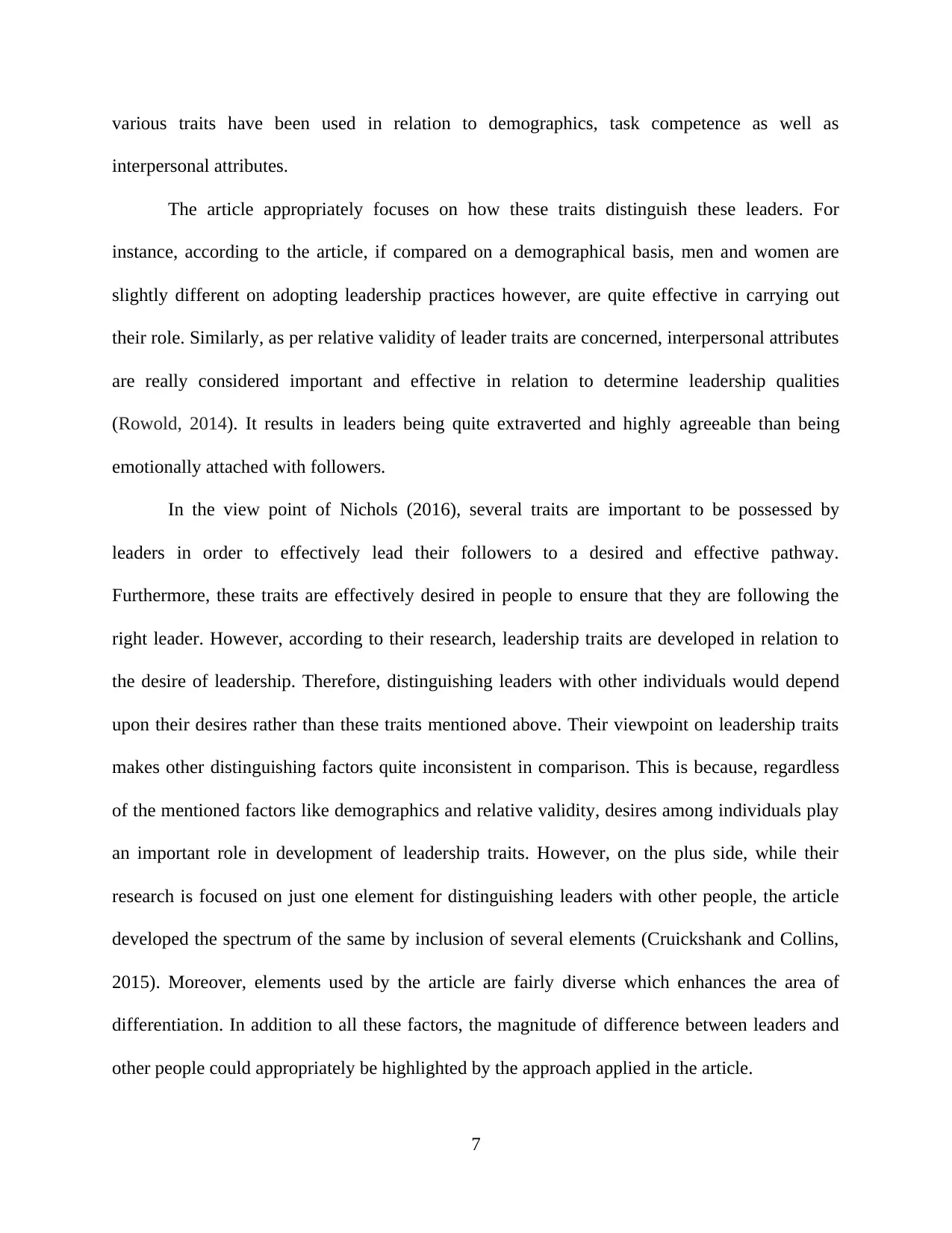
various traits have been used in relation to demographics, task competence as well as
interpersonal attributes.
The article appropriately focuses on how these traits distinguish these leaders. For
instance, according to the article, if compared on a demographical basis, men and women are
slightly different on adopting leadership practices however, are quite effective in carrying out
their role. Similarly, as per relative validity of leader traits are concerned, interpersonal attributes
are really considered important and effective in relation to determine leadership qualities
(Rowold, 2014). It results in leaders being quite extraverted and highly agreeable than being
emotionally attached with followers.
In the view point of Nichols (2016), several traits are important to be possessed by
leaders in order to effectively lead their followers to a desired and effective pathway.
Furthermore, these traits are effectively desired in people to ensure that they are following the
right leader. However, according to their research, leadership traits are developed in relation to
the desire of leadership. Therefore, distinguishing leaders with other individuals would depend
upon their desires rather than these traits mentioned above. Their viewpoint on leadership traits
makes other distinguishing factors quite inconsistent in comparison. This is because, regardless
of the mentioned factors like demographics and relative validity, desires among individuals play
an important role in development of leadership traits. However, on the plus side, while their
research is focused on just one element for distinguishing leaders with other people, the article
developed the spectrum of the same by inclusion of several elements (Cruickshank and Collins,
2015). Moreover, elements used by the article are fairly diverse which enhances the area of
differentiation. In addition to all these factors, the magnitude of difference between leaders and
other people could appropriately be highlighted by the approach applied in the article.
7
interpersonal attributes.
The article appropriately focuses on how these traits distinguish these leaders. For
instance, according to the article, if compared on a demographical basis, men and women are
slightly different on adopting leadership practices however, are quite effective in carrying out
their role. Similarly, as per relative validity of leader traits are concerned, interpersonal attributes
are really considered important and effective in relation to determine leadership qualities
(Rowold, 2014). It results in leaders being quite extraverted and highly agreeable than being
emotionally attached with followers.
In the view point of Nichols (2016), several traits are important to be possessed by
leaders in order to effectively lead their followers to a desired and effective pathway.
Furthermore, these traits are effectively desired in people to ensure that they are following the
right leader. However, according to their research, leadership traits are developed in relation to
the desire of leadership. Therefore, distinguishing leaders with other individuals would depend
upon their desires rather than these traits mentioned above. Their viewpoint on leadership traits
makes other distinguishing factors quite inconsistent in comparison. This is because, regardless
of the mentioned factors like demographics and relative validity, desires among individuals play
an important role in development of leadership traits. However, on the plus side, while their
research is focused on just one element for distinguishing leaders with other people, the article
developed the spectrum of the same by inclusion of several elements (Cruickshank and Collins,
2015). Moreover, elements used by the article are fairly diverse which enhances the area of
differentiation. In addition to all these factors, the magnitude of difference between leaders and
other people could appropriately be highlighted by the approach applied in the article.
7
Paraphrase This Document
Need a fresh take? Get an instant paraphrase of this document with our AI Paraphraser
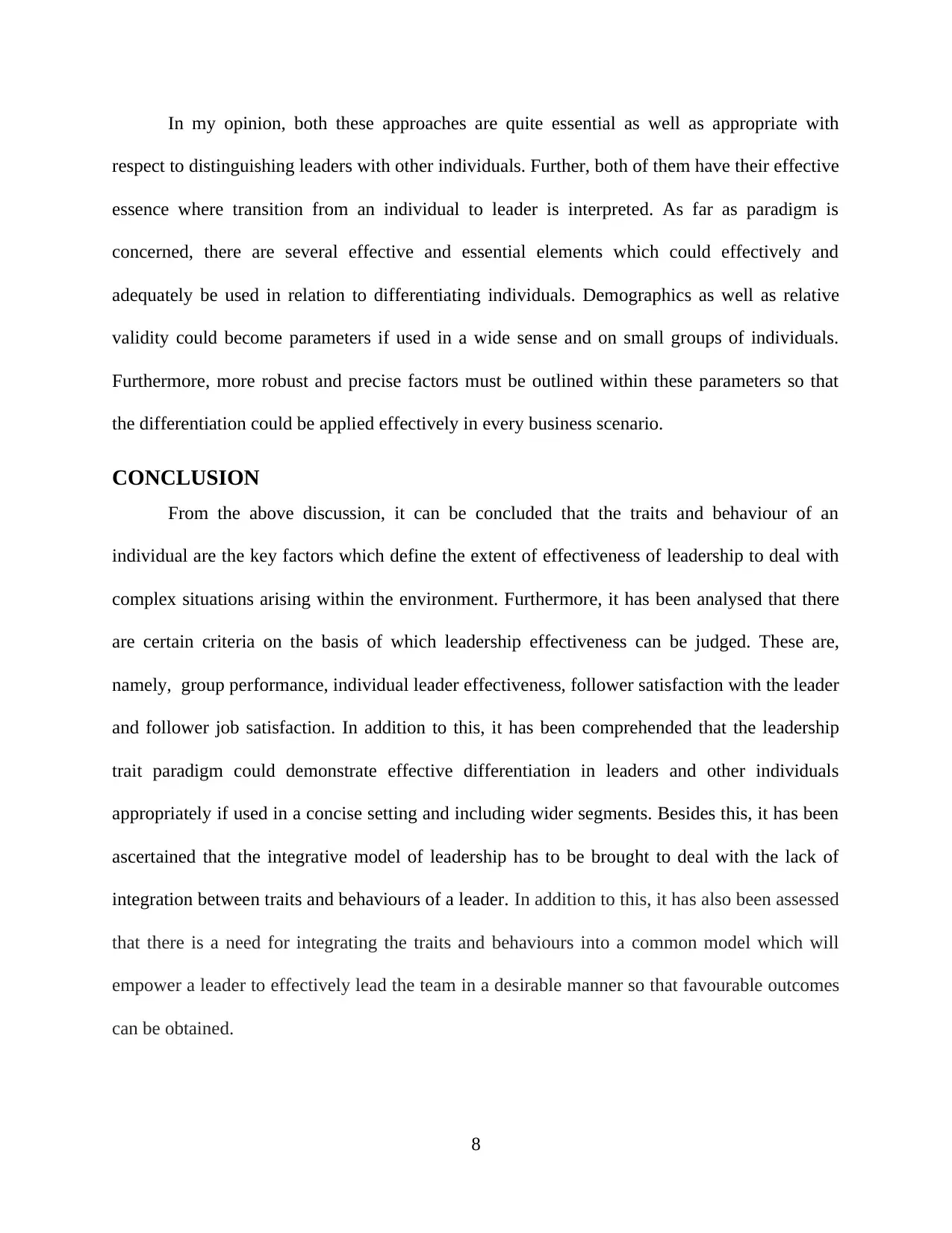
In my opinion, both these approaches are quite essential as well as appropriate with
respect to distinguishing leaders with other individuals. Further, both of them have their effective
essence where transition from an individual to leader is interpreted. As far as paradigm is
concerned, there are several effective and essential elements which could effectively and
adequately be used in relation to differentiating individuals. Demographics as well as relative
validity could become parameters if used in a wide sense and on small groups of individuals.
Furthermore, more robust and precise factors must be outlined within these parameters so that
the differentiation could be applied effectively in every business scenario.
CONCLUSION
From the above discussion, it can be concluded that the traits and behaviour of an
individual are the key factors which define the extent of effectiveness of leadership to deal with
complex situations arising within the environment. Furthermore, it has been analysed that there
are certain criteria on the basis of which leadership effectiveness can be judged. These are,
namely, group performance, individual leader effectiveness, follower satisfaction with the leader
and follower job satisfaction. In addition to this, it has been comprehended that the leadership
trait paradigm could demonstrate effective differentiation in leaders and other individuals
appropriately if used in a concise setting and including wider segments. Besides this, it has been
ascertained that the integrative model of leadership has to be brought to deal with the lack of
integration between traits and behaviours of a leader. In addition to this, it has also been assessed
that there is a need for integrating the traits and behaviours into a common model which will
empower a leader to effectively lead the team in a desirable manner so that favourable outcomes
can be obtained.
8
respect to distinguishing leaders with other individuals. Further, both of them have their effective
essence where transition from an individual to leader is interpreted. As far as paradigm is
concerned, there are several effective and essential elements which could effectively and
adequately be used in relation to differentiating individuals. Demographics as well as relative
validity could become parameters if used in a wide sense and on small groups of individuals.
Furthermore, more robust and precise factors must be outlined within these parameters so that
the differentiation could be applied effectively in every business scenario.
CONCLUSION
From the above discussion, it can be concluded that the traits and behaviour of an
individual are the key factors which define the extent of effectiveness of leadership to deal with
complex situations arising within the environment. Furthermore, it has been analysed that there
are certain criteria on the basis of which leadership effectiveness can be judged. These are,
namely, group performance, individual leader effectiveness, follower satisfaction with the leader
and follower job satisfaction. In addition to this, it has been comprehended that the leadership
trait paradigm could demonstrate effective differentiation in leaders and other individuals
appropriately if used in a concise setting and including wider segments. Besides this, it has been
ascertained that the integrative model of leadership has to be brought to deal with the lack of
integration between traits and behaviours of a leader. In addition to this, it has also been assessed
that there is a need for integrating the traits and behaviours into a common model which will
empower a leader to effectively lead the team in a desirable manner so that favourable outcomes
can be obtained.
8
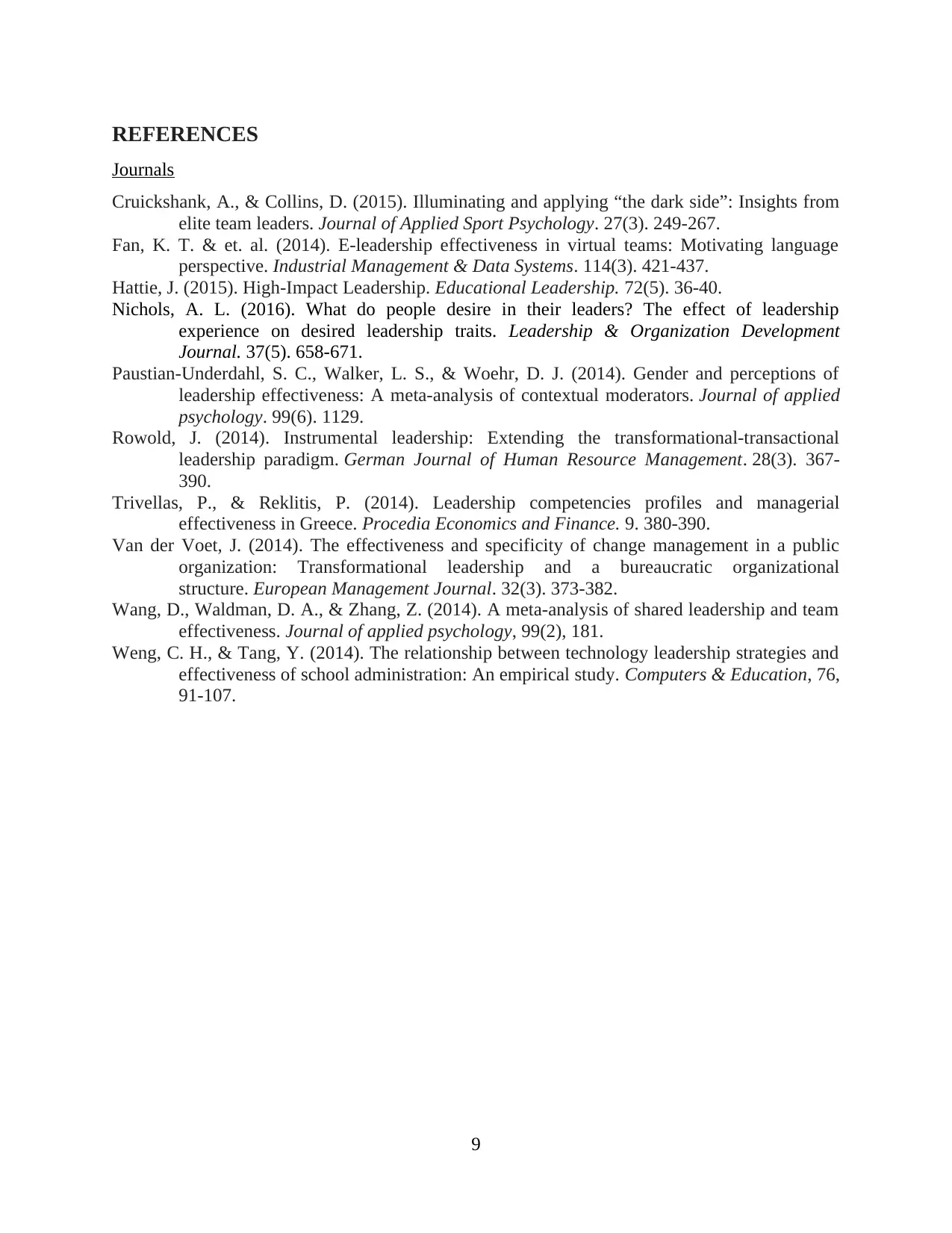
REFERENCES
Journals
Cruickshank, A., & Collins, D. (2015). Illuminating and applying “the dark side”: Insights from
elite team leaders. Journal of Applied Sport Psychology. 27(3). 249-267.
Fan, K. T. & et. al. (2014). E-leadership effectiveness in virtual teams: Motivating language
perspective. Industrial Management & Data Systems. 114(3). 421-437.
Hattie, J. (2015). High-Impact Leadership. Educational Leadership. 72(5). 36-40.
Nichols, A. L. (2016). What do people desire in their leaders? The effect of leadership
experience on desired leadership traits. Leadership & Organization Development
Journal. 37(5). 658-671.
Paustian-Underdahl, S. C., Walker, L. S., & Woehr, D. J. (2014). Gender and perceptions of
leadership effectiveness: A meta-analysis of contextual moderators. Journal of applied
psychology. 99(6). 1129.
Rowold, J. (2014). Instrumental leadership: Extending the transformational-transactional
leadership paradigm. German Journal of Human Resource Management. 28(3). 367-
390.
Trivellas, P., & Reklitis, P. (2014). Leadership competencies profiles and managerial
effectiveness in Greece. Procedia Economics and Finance. 9. 380-390.
Van der Voet, J. (2014). The effectiveness and specificity of change management in a public
organization: Transformational leadership and a bureaucratic organizational
structure. European Management Journal. 32(3). 373-382.
Wang, D., Waldman, D. A., & Zhang, Z. (2014). A meta-analysis of shared leadership and team
effectiveness. Journal of applied psychology, 99(2), 181.
Weng, C. H., & Tang, Y. (2014). The relationship between technology leadership strategies and
effectiveness of school administration: An empirical study. Computers & Education, 76,
91-107.
9
Journals
Cruickshank, A., & Collins, D. (2015). Illuminating and applying “the dark side”: Insights from
elite team leaders. Journal of Applied Sport Psychology. 27(3). 249-267.
Fan, K. T. & et. al. (2014). E-leadership effectiveness in virtual teams: Motivating language
perspective. Industrial Management & Data Systems. 114(3). 421-437.
Hattie, J. (2015). High-Impact Leadership. Educational Leadership. 72(5). 36-40.
Nichols, A. L. (2016). What do people desire in their leaders? The effect of leadership
experience on desired leadership traits. Leadership & Organization Development
Journal. 37(5). 658-671.
Paustian-Underdahl, S. C., Walker, L. S., & Woehr, D. J. (2014). Gender and perceptions of
leadership effectiveness: A meta-analysis of contextual moderators. Journal of applied
psychology. 99(6). 1129.
Rowold, J. (2014). Instrumental leadership: Extending the transformational-transactional
leadership paradigm. German Journal of Human Resource Management. 28(3). 367-
390.
Trivellas, P., & Reklitis, P. (2014). Leadership competencies profiles and managerial
effectiveness in Greece. Procedia Economics and Finance. 9. 380-390.
Van der Voet, J. (2014). The effectiveness and specificity of change management in a public
organization: Transformational leadership and a bureaucratic organizational
structure. European Management Journal. 32(3). 373-382.
Wang, D., Waldman, D. A., & Zhang, Z. (2014). A meta-analysis of shared leadership and team
effectiveness. Journal of applied psychology, 99(2), 181.
Weng, C. H., & Tang, Y. (2014). The relationship between technology leadership strategies and
effectiveness of school administration: An empirical study. Computers & Education, 76,
91-107.
9
⊘ This is a preview!⊘
Do you want full access?
Subscribe today to unlock all pages.

Trusted by 1+ million students worldwide
1 out of 12
Related Documents
Your All-in-One AI-Powered Toolkit for Academic Success.
+13062052269
info@desklib.com
Available 24*7 on WhatsApp / Email
![[object Object]](/_next/static/media/star-bottom.7253800d.svg)
Unlock your academic potential
Copyright © 2020–2025 A2Z Services. All Rights Reserved. Developed and managed by ZUCOL.




